By Rachel Dutton, Paulding County Master Gardener Extension Volunteer
Every Spring and Fall, when wildflowers, ferns, native shrubs, and native trees awake from their dormancy, I have noticed the variety of ferns and wildflowers in my yard. Being a curious gardener, I wondered how many varieties of ferns could be found in Paulding County.
One of our past Master Gardeners, Dallas Ann Dennis, had done extensive research on ferns in Paulding County. She graciously gave me a list of the ferns she had identified and from that list came this article on ferns that are found in Paulding County.
Bracken Fern/Pteridium aquilinum

Bracken is a perennial fern that grows from thick, dark, long-creeping rhizomes. Single leaves arise at intervals from the rhizomes (leaves are not in clusters). Leaf stems are erect and straw-colored to light brown. Found in dry locations – open roadsides, thinly wooded flats, and hillsides, in full or partial sun. Bracken Fern is one of the most widespread ferns in North America. It is invasive and poisonous to humans and livestock.
Broad Beech Fern/Phegopteris hexagonoptera
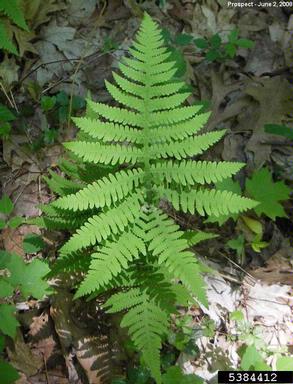
Broad Beech Fern is a perennial native fern that prefers moist, rich, well-drained, acidic soils in partial to deep shade. The deciduous leaves are produced directly from the shallow rhizomes in spring. The fronds are 10-30” long and spread out in rows or loose clusters. The fronds are a dull green color, slightly hairy on the lower surface, broadly triangular and tilt backward. In the fall, the fronds turn pale yellow.
Christmas Fern/Polytsitchum acrostichoides
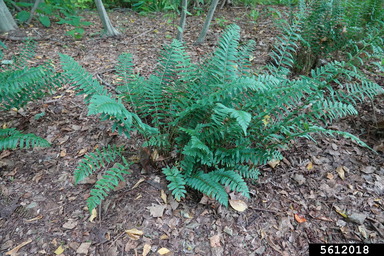
Christmas ferns occur in both dry and moist wooded slopes, moist banks, and ravines. It is one of the most common ferns in Georgia, except in the pine flatwoods of the southeastern part of the state. Typically grows in a fountain-like clump to 2′ tall and features leathery, lance-shaped, evergreen (green at Christmas time) fronds. The pinnae (leaflet) of Christmas fern are distinctive as they have a lobe that has the appearance of a toe of a Christmas stocking or a sleigh. The fiddleheads are also distinctive, with silvery, white scales.
Cinnamon Fern/Osmundastrum cinnamomeum
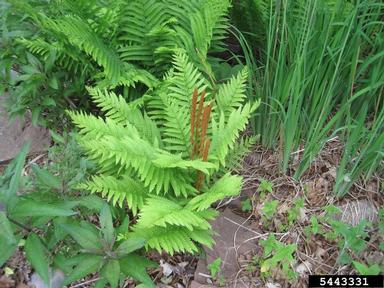
Cinnamon fern is a native fern that occurs in moist, boggy ground along streams and on shaded ledges and bluffs in part shade to full shade. It typically grows in clumps to 2-3′ tall, but with constant moisture can reach 6′ in height. The familiar “fiddleheads” also emerge from the base of the plant and unfurl into large, erect, pinnately-compound, yellowish-green, sterile fronds (2-4′ long) which remain attractive throughout the summer and turn yellow in autumn. The common name of this plant is in reference to the cinnamon-colored fibers found near the frond bases. Hummingbirds collect the soft down from the hairy stripes to line their nest. Osmunda fiber are a fibrous mass of dried fern roots and stipe tissue is used in the potting of orchids and epiphytes and comes from the roots of Cinnamon ferns.
Cutleaf Grape/Botrychium dissectum
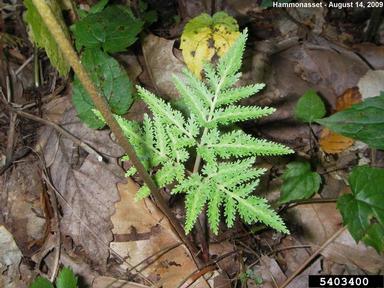
Dissected Grape is a native leathery evergreen fern sometimes called a Cut Leaf Grape Fern. Grape Ferns are named because their clustered spores resemble bunches of grapes. The leaflets are typically dissected and have a lacy appearance. In the fall, the fronds are bright green, and during the winter, the foliage is bronze-colored. When chilly winter temperatures occur, the sterile leaf transitions from green to bronze. The foliage will remain present until it withers early in the spring or summer. Grape ferns prefer partial to rich moist shady areas with good drainage.
Ebony Spleenwort/Asplenium platyneuron
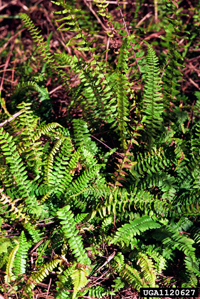
Ebony spleenwort is native to all of Georgia except the southeastern Coastal Plain. It produces two kinds of leaves: fertile ones, that bear spores on their undersides, and vegetative ones, that usually lie against the ground. The leaflet bases usually overlap the shiny, reddish-brown main stalk. Prefers partial shade to sun; not particular about soil types; prefers consistently moist soil. This small fern is lacy and evergreen. Ebony spleenwort occurs in rocky woods. Birds sometimes use old fronds for nesting material. The name “spleenwort” came from an ancient belief that any plant that had a structure shaped like a human body part could be used medicinally to treat ailments for that body part. Because the spore clusters of Asplenium species were spleen-shaped, people thought these plants might heal diseases of the spleen. “Wort,” is used in many plant names, is an old word for “herb.”
Ground Cedar/Lycopodium digitatum
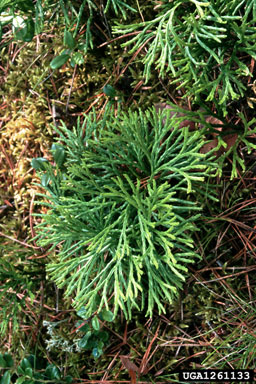
Other common names for ground cedar are running cedar, fan club moss, crows’ foot, and bear paw. It is native to moist, shady areas – woods, ravines, rocky slopes, and the marginal edges of swamps. Despite the name, club moss are not true mosses but are a spore-producing plants in the fern family. The small fern like plants is in the family Lycopodiaceae, a family of fern-allies. While not a fern, it is related to ferns and forms large colonies. As the various common names suggest, the greenery looks somewhat like cedar boughs. The leaves are flattened along one side, waxy to shiny, and dark green. The plants are 4 to 8 inches in height and spread by runners above the ground. Fallen pine needles or leaves often obscure the runners.
Hairy Lip Fern/Cheilanthes lanosa
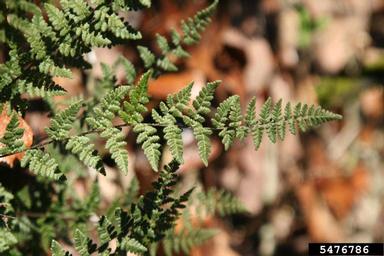
This native species is a dry land fern that prefers a loose, gritty rock setting and partial or full sun. It’s short creeping rhizome produces stipes covered in hairs that help
The common name, “hairy lip fern”, comes from the location of the sporangia at the edge or lip of the leaf, “hairy” refers to the presence of hairs.
Marsh Fern/Thelypteris palustris
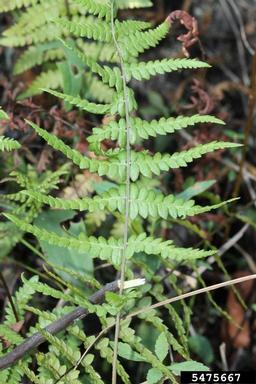
In Georgia Marsh ferns are found primarily in the Coastal Plains, while widely distributed it is not abundant. This is a common fern of wet sunny places, though it does tolerate light shade and is not typically found in standing water. A non-clumping fern, it often forms colonies from its long creeping rhizomes.
Netted Chain Fern/Woodwardia areolata
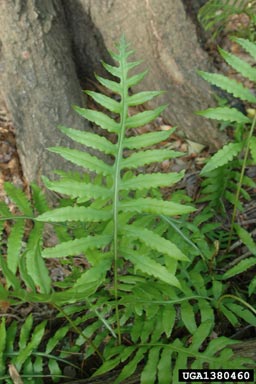
Netted Chain Fern produces upright reddish-green fronds in early spring that become glossy dark green as they mature. One of the most widespread ferns in Georgia. Wide good distribution in the state. This species is found in swamps or very wet conditions, such as the edges of ponds, throughout eastern North America. Some Native American tribes used ferns of the Woodwardia genus for making baskets and dyes.
Northern Maidenhair Fern/Adiantum pedatum
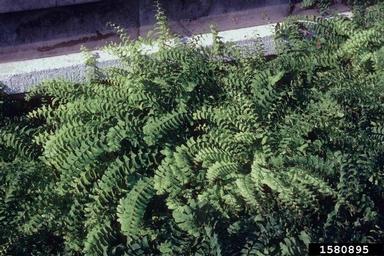
Northern Maidenhair Fern is a deciduous, clump-forming, native fern that typically grows 1.5 to 2′ tall and is most frequently found on rich wooded slopes, ravine bottoms, and damp shady woods. Features finely textured, somewhat frilly fronds have curved stalks. Wiry stems are reddish-brown to black. Coiled young fiddleheads emerge pink in spring. Many tribes throughout North America used all parts of this fern as medicine and in basketry. Bottom of Form
Rattlesnake Fern/Botrychium virginianum
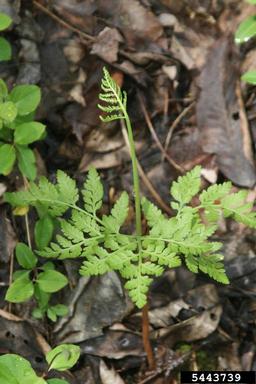
It is one of the first ferns to begin growth in spring. The common name, Rattlesnake Fern, refers to the clusters of sporangia that resemble a snake “rattle.” Rattlesnake Fern leaves also wither away by fall whereas most grape fern leaves persist through winter. The plant may grow from 1 foot to 4 feet at maturity. The root system consists of fibrous rhizomes. The leaves of the Rattlesnake Fern are light green, and the stalks are light green to red. Rattlesnake Fern fronds are thin, non-leathery, and delicate. Once the sporangia mature, the spores are released and distributed by the wind. The plant has no flowers or fruit.
Resurrection Fern/Pleopeltis polypodioides

This native fern is an epiphyte or air plant. It makes its home growing on other plants, but it still photosynthesizes the way other plants do. This plant can lose about 75 percent of its water content during a typical dry period and possibly up to 97 percent in an extreme drought. During this time, it shrivels up to a grayish-brown clump of leaves. When it is exposed to water again, it will “come back to life” and look green and healthy. The plant gets its name from this supposed “resurrection,” but it never actually dies during the process. By contrast, most other plants can lose only 10 percent of their water content before they die. Fronds are typically 4 to 12 inches in length. Due to its ability to withstand drought, it can be found in a variety of habitats, but it needs a host plant or other substrate on which to anchor itself. Resurrection ferns often favor oak trees.
Royal Fern/Osmunda regalis

Osmunda regalis, commonly called royal fern, is a tall, deciduous native fern that usually occurs on moist bluffs and ledges and along streams Typically grows in clumps to 2-3′ tall, but with constant moisture and can reach 6′ in height. Broad fronds have large, well-separated pinnae (leaflets) which give this fern an almost pea-family appearance. Fronds typically turn yellow to brown in autumn. Spores are in brown, tassel-like, fertile clusters at the tips of the fronds, thus giving rise to the additional common name of flowering fern for this plant. Osmunda fiber used in the potting of orchids comes from the fibrous roots of these ferns.
Common Lady Fern/ Athyrium filix-femina

Common Lady Fern is found throughout most of Georgia, except the piney flatwoods in the southeastern part of the state. There are several species of Lady Ferns found in North America, but only this species is native to Georgia. This fern is found in moist woods, roadside banks, along streams, and swamp margins.
The author of this article, Rachel Dutton, is a Paulding UGA Extension Master Gardener. Master Gardeners are trained to provide education for homeowners on horticulture, sustainable landscaping, and environmentally friendly gardening practices using unbiased, research-based information from the University of Georgia.
The following sources were used in preparing this article and contain more information about ferns in Paulding County and Georgia.
Field Guide to the Ferns and other Pteridophytes of Georgia, by Lloyd H. Snyder, Jr, and James G. Bruce. The University of Georgia Press.
Peterson Field Guide to Ferns of Northeastern and Central North America, by Boughton Cobb and Elizabeth Farnsworth and Cheryl Lowe for the New England Wildflower Society.
Native Plants for Georgia Part 2: Ferns, Publication B987-2 is now available online. This is a great resource for Master Gardeners and others who are interested in native ferns. There are wonderful line drawings, photographs, and information on identification and culture. https://extension.uga.edu/publications/detail.html?number=B987-2
USDA Forest Service, Forest Management, Rangeland Management, & Vegetation Ecology – Botany Program
1400 Independence Ave SW,3rd Floor SW Mailstop 1153, Washington DC 20250-1153
The North Carolina Extension Gardener Plant Toolbox, https://plants.ces.ncsu.edu/